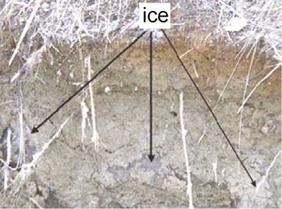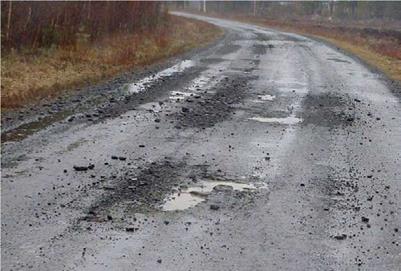The Effect of Temperature
Pore suctions have the effect of “pulling” the saturated zone nearer the ground surface than it would otherwise have been from where evaporation becomes possible. When evaporation is significant then upward water flow takes place to replace the water being evaporated. Evapotranspiration by vegetation also introduces an upward water flow towards roots in a similar manner. In hot climates, evaporation can lead to upward moving water tens of metres above the phreatic surface and it can also lead to salts being lifted to the surface where they precipitate out in the soil pores forming calcretes and silcretes (Sabkha soils are an example of this).
Another cause of suction is seasonal ground freezing in high latitudes or at high altitudes. For reasons explained in Chapter 4, considerable ice wedges may form at the boundary between freezing caused by cold road surface temperatures and underlying non-frozen soils (Fig. 1.8). By this means, soils may heave by hundreds of millimetres in a winter season.
In spring, this ice melts, but the warmth comes from the surface so that the ice nearest the surface melts first. As there is still ice below it (and probably in the margin of the roads where the surrounding ground is covered by snow and ice cleared from the road pavement), the water from the melted ice has nowhere to drain and extremely weak conditions can result (Fig. 1.9).
 |
 |
Just as evaporation, evapotranspiration and freezing are non-constant processes drawing water up from the groundwater zone, so rainfall is an intermittent supplier of water at, or near (via drains or soakaways) the surface causing a downward flow. A small amount of rain very rapidly cancels a high suction (thus suddenly reducing the effective stress and the frictional strength of a soil – see Section 1.4.3). It is partly for this reason that wet weather is so often associated with occurrence of slope distress in earthworks and in deformation of pavements.
|
Fig. 1.9 Thin asphaltic surfacing of a road lifted by traffic-induced water pressure during spring-thaw in Northern-Karelia, Finland. Reproduced by permission of M. Leppanen |







Leave a reply